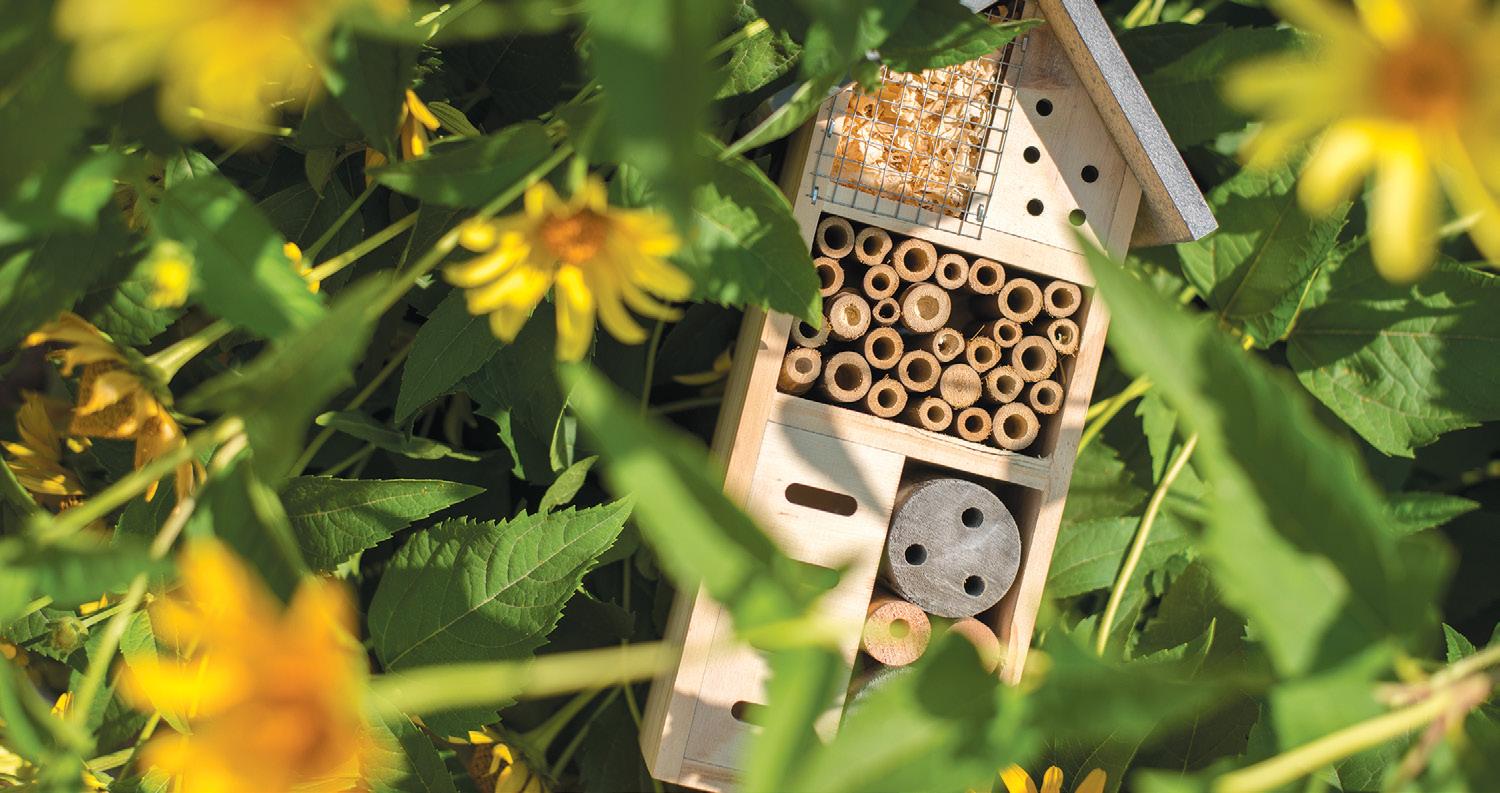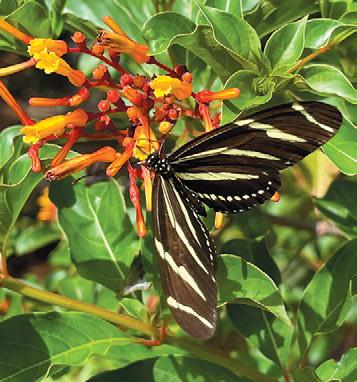
4 minute read
POLLINATOR HAVEN
CREATE A TOXIN-FREE YARD FOR CRITICAL CRITTERS
by Sandra Yeyati
Advertisement
Aimée Code has stopped trying to grow roses in her Eugene, Oregon, backyard, where the ground is too muddy for them to flourish. If we stick to plants that do well in our own region, they’ll be less susceptible to disease and pests, and we won’t need to use dangerous chemicals in our gardens, says the pesticide program director at the Xerces Society for Invertebrate Conservation.
Code works to preserve invertebrate species that are threatened by habitat loss, climate change and pesticides. “Many of these animals provide valuable services,” she says. “Solitary wasps feed their young certain caterpillars that we consider pests because they eat our crops. Riverbed mussels filter our water. Stone flies help break down organic matter. Bees are effective pollinators, helping to sustain our most nutritious food sources.”
U.S. bees are declining at alarming rates, thanks in part to neonicotinoids and other harmful pesticides, Code reports. The good news is that a few gardening modifications can provide food and safe haven for beneficial invertebrates, while keeping our families (and pets) free from scary chemicals.
Gardening Tips from Aimée Code
Create a resilient garden with hardy, native plants that invite both pollinators and natural enemies like solitary wasps, lacewings and hoverflies, which help control pest populations. Use restraint when trimming plants or clearing debris. Many bees create nests inside pithy stems and downed wood or underneath bunch grasses and fallen leaves.
Develop a greater tolerance for weeds, embracing a slightly wilder garden aesthetic. Avoid using herbicides by mulching and manually pulling weeds before they go to seed.
A few pests in the vegetable garden are okay, as long as they don’t harm overall production. Search online for nonchemical solutions by vegetable type and location. As in farming, try rotating crops or look into companion planting to learn which plants work well together. Ensure the soil has what each plant needs. For example, blueberries require an acidic soil.
Pesticides address the symptom rather than the problem. Killing pests may be a temporary fix, but won’t address the
underlying cause, so the problem will likely return. Even so-called “reduced risk” products contain concerning chemicals for pollinators. Always try non-chemical solutions first. For example, instead of applying a fungicide to address powdery mildew, water the affected plant less and prune it to improve air flow.
Eco-Friendly Pest Management
According to Ryan Anderson, community integrated pest management manager at the IPM Institute of North America, “Chemicals should only be used in a lawn or garden as a last resort, and even then, only the least amount of the least harmful product.” For reduced-risk and organic product lists, visit Tinyurl.com/EPAPesticideList and MidwestGrowsGreen.org.
Anderson laments the rampant overuse of noxious products, including glyphosate and 2,4-D, which are classified as probable and possible carcinogens, respectively, by the International Agency for Research on Cancer; commercial fertilizers that lead to nitrogen and phosphorus runoffs, threatening marine wildlife; and pyrethroid insecticides for mosquito control, which kill most insects.
He champions sustainable measures, starting with a reduction of turf grass. “People like sitting on their lawn, but try keeping it as minuscule as possible and plant native plants which require less maintenance,” he says. “Make sure you’re not planting grass where grass doesn’t want to grow.”
Consider an eco-lawn with micro-clover in the mix, Anderson advises. “Clover recycles nitrogen and stays green in drought conditions, so you don’t have to fertilize or water, and you only need to mow eco-lawns once a month.”
Lawn Care Strategies from Ryan Anderson

For weeds, the best defense is a dense, deeply rooted, turf grass system that will out-compete for air, water, nutrients and sunlight.
Aerate the lawn in the fall by removing narrow, three-to-sixinch-deep cores and leaving them on the soil. After a day or two, mow the cores over to return nutrients to the soil. Spread turf seed over bare-soil areas and over the entire lawn whenever aeration is conducted.
Before or after aerating, spread one-quarter to one-half inch of compost over the lawn to promote a nutrient- and microbiologyrich, spongy soil structure. Visit CompostingCouncil.org for reputable suppliers and DIY instructions for high-quality compost.
Apply leaf mulch and grass clippings to feed and promote protozoa, bacteria and fungi that break down organic matter, recycle nutrients, inhibit plant pathogens, balance pH and aerate the soil.
Mow less often and as high as possible to minimize stressing the grass plant. Lawns need only a single, one-inch watering per week.
Sandra Yeyati, J.D., is a professional writer and editor. Reach her at SandraYeyati@gmail.com.

photo by Sandra Yeyati

Final Journey, LLC
(Pet Euthanasia Service) Kristen Klie, D.V.M. and Associates
(203) 645-5570 www.finaljourneyllc.com
Maintain your youth
with Homeopathic HGH Transdermal Gel Maximum Strength Somatropin
Unique and affordable alternative designed to support your pituitary gland! Usage may
• Improve Bone and Joint Health • Improve Sleep • Increase Muscle and Reduce Fat Contact Shirley R. Bloethe 860-989-0033 or www.PassItOnLLC.com
Cheryl Tuttle & Marcy LaBella Earthlygoddess02@gmail.com
EARTHLY GODDESS
Art that Nurtures the Soul
Clay
Drawing
Painting
Fiber Arts
Jewelry
Mixed Media
860•349•0251
352 Main St.-Rear Durham, CT 06422 Check out our class schedule in the calendar section! facebook.com/earthlygoddess3




